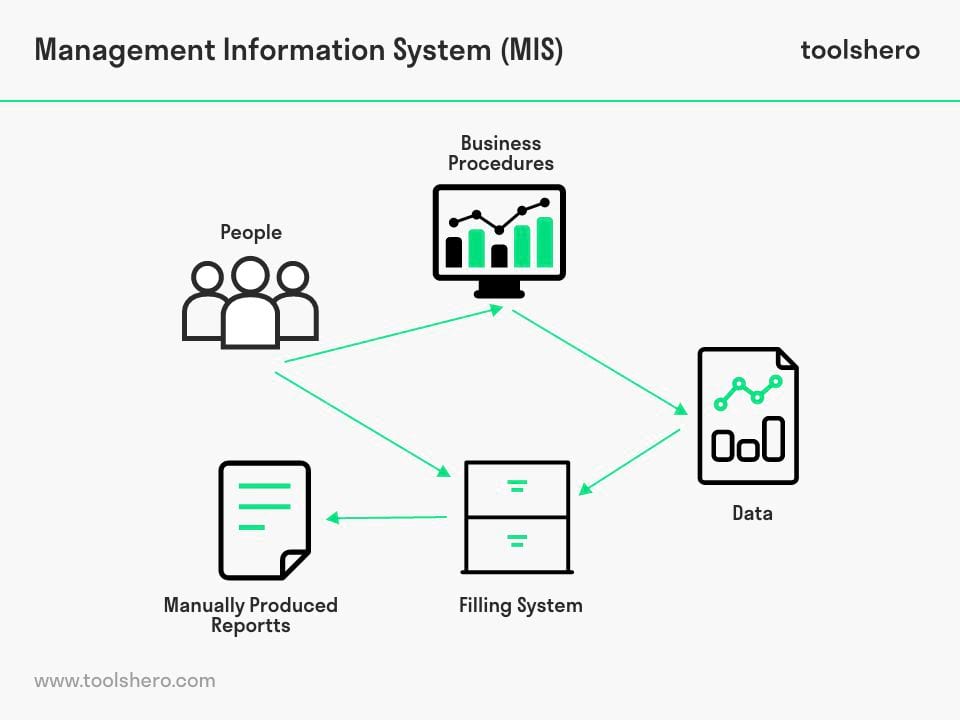Management Information System (MIS)

Management Information System (MIS): This article explains the management information system (MIS) in a practical way. Next to the definition, also this article highlights it’s background, technology, the future and advantages / disadvantages of this powerful information technology tool. Enjoy Reading!
What is a management information system?
A management information system (MIS) is an IT solution that is used to support decision-making and used for the coordination, control, analysis and visualization of different types of information within an organization. When it comes to management information systems within an organization, the system encompasses business processes, technology and people.
The general purpose of MIS in a business sense is to increase the value and profit of a company.
By leveraging a dependable IMS – Information Management Services, management gains the ability to make well-informed decisions using pertinent and timely information. This section will explore the extensive advantages that MIS offers to organizations.
Definition
A management information system (MIS) is a collection of separate systems, procedures and processes that combine data from different sources and present it in a manageable format.
Managers use a MIS to access reports that give them an overview of all the information they need for their decision-making. This decision-making concerns both day-to-day matters and matters that concern the long-term strategy.

Figure 1 – overview of a Management Information System set-up
Background
The concept of a MIS predates the existence of modern computer technologies. Today, the systems largely rely on technology to collect and interpret data.
The development of such systems can be divided into five phases, or eras.
- First era of mainframe and minicomputer computing
- Second era of personal computers
- Third era of client/server networks
- Fourth era of enterprise computing
- Fifth era of Cloud Computing
The first era was dominated by IBM, who produced both the hardware and software for their own mainframe computers.
Technology of a Management Information System
Since the first solutions for information systems, many solutions have been added. There are a number of systems that are often confused. For example:
- Management information systems (MIS)
- Information management systems
- Information systems
- Enterprise resource planning (ERP)
- Computer science
- Electrical computer engineering
- Information technology management
These systems are a subset of these information systems. The systems are purely organization-focused, meaning they must provide value in their day-to-day use for management and decision-making.
Computer science is more focused on software and the development of help systems that can then be used in MIS. Electrical computer engineering is more focused on the hardware of systems. ERP is a subset of MIS and Information Technology Management includes managing IT systems which may include MIS.
The future of the management information system
The complexity of information systems continues to increase over time. Nevertheless, the engineers and users are asked to understand the systems in an instant and to know how the different systems fit into the structure of an organization.
The challenges associated with this also offer opportunities. The future of management information systems is one with opportunities for everyone. System visualization is the process of mapping flows or processes within a system, server, or data flow. This visualization makes it easy for teams to identify, communicate, and update issues.
The increasing complexity of systems
The complexity of systems increases every day. Research shows that in 2013, an average of 22 technological systems or components were used for a single web or mobile transaction. In 2018, that number averaged 35.
More and more connectivity and dependence on digital devices mean that complexity increases. This also means that vulnerable spots in the system can become visible. The number of system vulnerabilities is also increasing.
The challenge is to prevent unwanted break-ins and limit damage when attempts are made. This separate discipline is known as cyber security.
Cyber security has long ceased to be seen as an afterthought. It is integrated into systems development processes and systems engineers and systems analysts are committed to improving the overall security and resilience of the system.
Advantages and disadvantages of a Management Information System
The use of a MIS has both advantages and disadvantages. They are briefly explained below.
Advantages
Using a MIS, once it works properly, saves a lot of time and allows the company to avoid multiple forms of waste (LEAN).
In addition, a MIS facilitates and improves decision-making in the organization and stimulates efficient business operations. The information system acts as a tool that managers and other decision-makers can use to access historical and current data to support decision-making.
Another advantage of a MIS is that it increases visibility into business processes and performance. This also makes it easier to actually manage the business processes.
Automated MIS also ensure a streamlined supply chain. This in turn creates additional value for the consumer. It also improves the flow of information from the organization to the customer, for example updates about where an order is in the process.
Well-functioning MIS also make employee evaluations more accurate. The systems are used by HRM managers, who deploy the systems to track and manage employee data, payrolls and employee communications.
Such systems (HR Analytics) are able to directly access employee reports, resources and other management information regarding personnel through automated dashboards.
Disadvantages
There are also drawbacks to using MIS. One of these drawbacks is the fact that these systems are often very expensive. A lot of capital is needed to build the system and start it up. In addition, in the event of a transition from manual to automatic information provision, it will take over the function of employees.
The MIS is a highly sensitive technology that requires continuous monitoring. This takes time and resources.
Many information systems show a lack of flexibility in practice. It is designed for a specific purpose and it is often difficult to adapt the system.
Now it’s Your Turn
What do you think? Do you recognize the explanation about the MIS? Do you work with a MIS? Or do your managers work with such a system? Do you think that the information provision for organizations will look different in the coming years due to technological progress?
Share your experience and knowledge in the comments box below.
More information
- Martins, J., Branco, F., Gonçalves, R., Au-Yong-Oliveira, M., Oliveira, T., Naranjo-Zolotov, M., & Cruz-Jesus, F. (2019). Assessing the success behind the use of education management information systems in higher education. Telematics and Informatics, 38, 182-193.
- Laudon, K. C., & Laudon, J. P. (2015). Management information system. Pearson Education India.
- Laudon, K. C., & Laudon, J. P. (2011). Essentials of management information systems.
- Gallagher, C. A. (1974). Perceptions of the value of a management information system. Academy of Management Journal, 17(1), 46-55.
How to cite this article:
Janse, B. (2022). Management Information System (MIS). Retrieved [insert date] from Toolshero: https://www.toolshero.com/information-technology/management-information-system/
Original publication date: 11/17/2022 | Last update: 04/04/2024
Add a link to this page on your website:
<a href=”https://www.toolshero.com/information-technology/management-information-system/”> Toolshero: Management Information System (MIS)</a>












